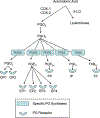Prostaglandins in asthma and allergic diseases
- PMID: 30081047
- PMCID: PMC6309751
- DOI: 10.1016/j.pharmthera.2018.08.001
Prostaglandins in asthma and allergic diseases
Abstract
Prostaglandins are synthesized through the metabolism of arachidonic acid via the cyclooxygenase pathway. There are five primary prostaglandins, PGD2, PGE2, PGF2, PGI2, and thromboxane B2, that all signal through distinct seven transmembrane, G-protein coupled receptors. The receptors through which the prostaglandins signal determines their immunologic or physiologic effects. For instance, the same prostaglandin may have opposing properties, dependent upon the signaling pathways activated. In this article, we will detail how inhibition of cyclooxygenase metabolism and regulation of prostaglandin signaling regulates allergic airway inflammation and asthma physiology. Possible prostaglandin therapeutic targets for allergic lung inflammation and asthma will also be reviewed, as informed by human studies, basic science, and animal models.
Keywords: Allergy; Asthma; Cyclooxygenase; Lung; Prostaglandin.
Copyright © 2018 Elsevier Inc. All rights reserved.
Conflict of interest statement
Financial disclosures
The author declares that there are no conflicts of interest.
Figures




References
-
- Adam M, Boie Y, Rushmore TH, Muller G, Bastien L, McKee KT, . . . Abramovitz M (1994). Cloning and expression of three isoforms of the human EP3 prostanoid receptor. FEBS Letters, 338(2), 170–174. - PubMed
-
- Adamusiak AM, Stasikowska-Kanicka O, Lewandowska-Polak A, Danilewicz M, Wagrowska-Danilewicz M, Jankowski A, . . . Pawliczak R (2012). Expression of arachidonate metabolism enzymes and receptors in nasal polyps of aspirinhypersensitive asthmatics. Int. Arch. Allergy Immunol, 157(4), 354–362. doi:000329744[pii];10.1159/000329744[doi] - PubMed
-
- Aggarwal S, Moodley YP, Thompson PJ, & Misso NL (2010). Prostaglandin E2 and cysteinyl leukotriene concentrations in sputum: association with asthma severity and eosinophilic inflammation. Clin. Exp. Allergy, 40(1), 85–93. doi:CEA3386[pii];10.1111/j.1365-2222.2009.03386.x[doi] - PubMed
-
- Aizawa H, Inoue H, Nakano H, Matsumoto K, Yoshida M, Fukuyama S, . . . Hara N (1998). Effects of thromboxane A2 antagonist on airway hyperresponsiveness, exhaled nitric oxide, and induced sputum eosinophils in asthmatics. Prostaglandins Leukot. Essent. Fatty Acids, 59(3), 185–190. - PubMed
-
- Aksoy MO, Li X, Borenstein M, Yi Y, & Kelsen SG (1999). Effects of topical corticosteroids on inflammatory mediator-induced eicosanoid release by human airway epithelial cells. J. Allergy Clin. Immunol, 103(6), 1081–1091. - PubMed
Publication types
MeSH terms
Substances
Grants and funding
LinkOut - more resources
Full Text Sources
Other Literature Sources
Medical
Miscellaneous

